阅读2
英语阅读二课文及翻译
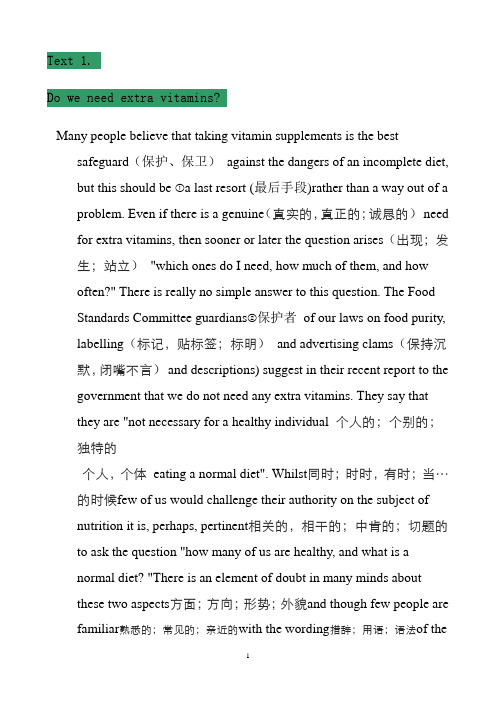
Text 1.Do we need extra vitamins?Many people believe that taking vitamin supplements is the best safeguard(保护、保卫)against the dangers of an incomplete diet, but this should be ①a last resort (最后手段)rather than a way out of a problem. Even if there is a genuine(真实的,真正的;诚恳的)need for extra vitamins, then sooner or later the question arises(出现;发生;站立)"which ones do I need, how much of them, and howoften?" There is really no simple answer to this question. The FoodStandards Committee guardians②保护者of our laws on food purity, labelling(标记,贴标签;标明)and advertising clams(保持沉默,闭嘴不言)and descriptions) suggest in their recent report to the government that we do not need any extra vitamins. They say thatthey are "not necessary for a healthy individual个人的;个别的;独特的个人,个体eating a normal diet". Whilst同时;时时,有时;当…的时候few of us would challenge their authority on the subject ofnutrition it is, perhaps, pertinent相关的,相干的;中肯的;切题的to ask the question "how many of us are healthy, and what is anormal diet? "There is an element of doubt in many minds aboutthese two aspects方面;方向;形势;外貌and though few people are familiar熟悉的;常见的;亲近的with the wording措辞;用语;语法of theFood Standards Report they do wonder instinctively本能地if theyare eating the right things. The blame for faulty eating habits is often placed at the door of the ubiquitous③(a. being everywhere, esp. atthe same time 普遍存在的)junk and convenience foods. As wehave seen, some of these are not the criminals they are made out tobe White bread is only slightly些微地,轻微地;纤细地less nutritious than brown bread and frozen vegetables can be almost as "fresh" asfresh food. There are very few foods which can really be described as pure rubbish. Many pre-packed goods contain too much sugar andwe would all benefit by avoiding these, but most tinned, processed处理的,加工过的and dried foods contain useful amounts of fat,protein, carbohydrate④(n. 碳水化合物), vitamins and minerals矿物;矿产,矿产品. The addition of a small amount of fruit or a side salad to convenience foods such as pizzas or hamburgers can turn asnack小吃,快餐;一份,部分into a well-balanced meal.许多人认为,服用维生互补剂是防止出现饮食营养不均衡情况的最好防范办法,但这是解决这一问题的方法中最不可行的作法。
托福TPO27阅读Passage2原文文本+题目+答案解析
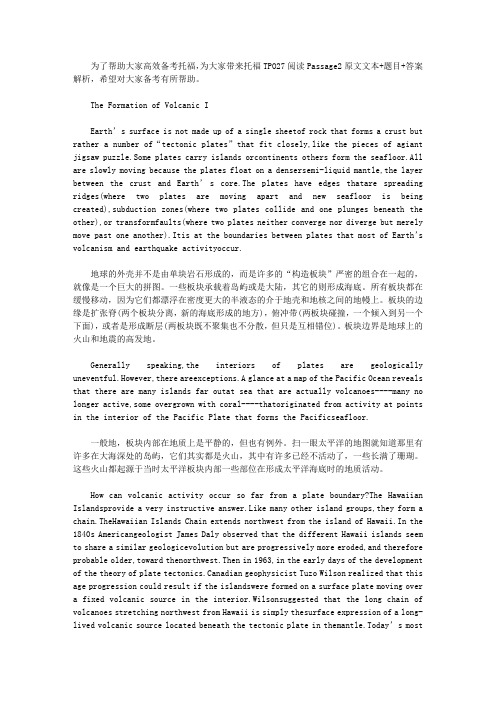
为了帮助大家高效备考托福,为大家带来托福TPO27阅读Passage2原文文本+题目+答案解析,希望对大家备考有所帮助。
The Formation of Volcanic I Earth’s surface is not made up of a single sheetof rock that forms a crust but rather a number of“tectonic plates”that fit closely,like the pieces of agiant jigsaw puzzle.Some plates carry islands orcontinents others form the seafloor.All are slowly moving because the plates float on a densersemi-liquid mantle,the layer between the crust and Earth’s core.The plates have edges thatare spreading ridges(where two plates are moving apart and new seafloor is being created),subduction zones(where two plates collide and one plunges beneath the other),or transformfaults(where two plates neither converge nor diverge but merely move past one another).Itis at the boundaries between plates that most of Earth’s volcanism and earthquake activityoccur. 地球的外壳并不是由单块岩石形成的,而是许多的“构造板块”严密的组合在一起的,就像是一个巨大的拼图。
剑桥雅思真题8-阅读Test 2(附答案)
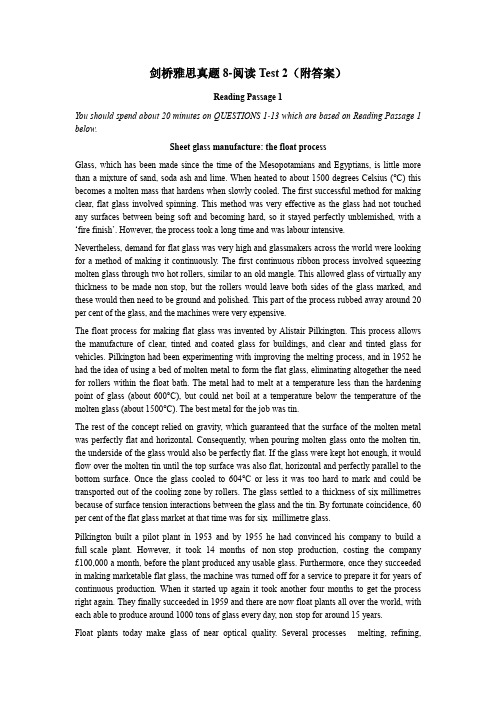
剑桥雅思真题8-阅读Test 2(附答案)Reading Passage 1You should spend about 20 minutes on QUESTIONS 1-13 which are based on Reading Passage 1 below.Sheet glass manufacture: the float processGlass, which has been made since the time of the Mesopotamians and Egyptians, is little more than a mixture of sand, soda ash and lime. When heated to about 1500 degrees Celsius (°C) this becomes a molten mass that hardens when slowly cooled. The first successful method for making clear, flat glass involved spinning. This method was very effective as the glass had not touched any surfaces between being soft and becoming hard, so it stayed perfectly unblemished, with a ‘fire finish’. However, the process took a long time and was labour intensive.Nevertheless, demand for flat glass was very high and glassmakers across the world were looking for a method of making it continuously. The first continuous ribbon process involved squeezing molten glass through two hot rollers, similar to an old mangle. This allowed glass of virtually any thickness to be made non-stop, but the rollers would leave both sides of the glass marked, and these would then need to be ground and polished. This part of the process rubbed away around 20 per cent of the glass, and the machines were very expensive.The float process for making flat glass was invented by Alistair Pilkington. This process allows the manufacture of clear, tinted and coated glass for buildings, and clear and tinted glass for vehicles. Pilkington had been experimenting with improving the melting process, and in 1952 he had the idea of using a bed of molten metal to form the flat glass, eliminating altogether the need for rollers within the float bath. The metal had to melt at a temperature less than the hardening point of glass (about 600°C), but could net boil at a temperature below the temperature of the molten glass (about 1500°C). The best metal for the job was tin.The rest of the concept relied on gravity, which guaranteed that the surface of the molten metal was perfectly flat and horizontal. Consequently, when pouring molten glass onto the molten tin, the underside of the glass would also be perfectly flat. If the glass were kept hot enough, it would flow over the molten tin until the top surface was also flat, horizontal and perfectly parallel to the bottom surface. Once the glass cooled to 604°C or less it was too hard to mark and could be transported out of the cooling zone by rollers. The glass settled to a thickness of six millimetres because of surface tension interactions between the glass and the tin. By fortunate coincidence, 60 per cent of the flat glass market at that time was for six- millimetre glass.Pilkington built a pilot plant in 1953 and by 1955 he had convinced his company to build a full-scale plant. However, it took 14 months of non-stop production, costing the company £100,000 a month, before the plant produced any usable glass. Furthermore, once they succeeded in making marketable flat glass, the machine was turned off for a service to prepare it for years of continuous production. When it started up again it took another four months to get the process right again. They finally succeeded in 1959 and there are now float plants all over the world, with each able to produce around 1000 tons of glass every day, non-stop for around 15 years.Float plants today make glass of near optical quality. Several processes -melting, refining,homogenising - take place simultaneously in the 2000 tonnes of molten glass in the furnace. They occur in separate zones in a complex glass flow driven by high temperatures. It adds up to a continuous melting process, lasting as long as 50 hours, that delivers glass smoothly and continuously to the float bath, and from there to a coating zone and finally a heat treatment zone, where stresses formed during cooling are relieved.The principle of float glass is unchanged since the 1950s. However, the product has changed dramatically, from a single thickness of 6.8 mm to a range from sub-millimetre to 25 mm, from a ribbon frequently marred by inclusions and bubbles to almost optical perfection. To ensure the highest quality, inspection takes place at every stage. Occasionally, a bubble is not removed during refining, a sand grain refuses to melt, a tremor in the tin puts ripples into the glass ribbon. Automated on-line inspection does two things. Firstly, it reveals process faults upstream that can be corrected. Inspection technology allows more than 100 million measurements a second to be made across the ribbon, locating flaws the unaided eye would be unable to see. Secondly, it enables computers downstream to steer cutters around flaws.Float glass is sold by the square metre, and at the final stage computers translate customer requirements into patterns of cuts designed to minimise waste.Question 1-8Complete the table and diagram below.Choose NO MORE THAN TWO WORDS from the passage for each answer.Write your answers in boxes on your answer sheet.Early methods of producing flat glassQuestion 9-13Do the following statements agree with the information given in Reading Passage 1?In boxes 9-13 on your answer sheet, writeTRUE if the statement agrees with the informationFALSE if the statement contradicts the informationNOT GIVEN if there is no information on this in the passage9. The metal used in the float process had to have specific properties.10. Pilkington invested some of his own money in his float plant.11. Pilkington's first full-scale plant was an instant commercial success.12. The process invented by Pilkington has now been improved.puters are better than humans at detecting faults in glass.Reading Passage 2You should spend about 20 minutes on QUESTIONS 14-26 which are based on Reading Passage 2 below.The Little Ice AgeA This book will provide a detailed examination of the Little Ice Age and other climatic shifts, but, before I embark on that, let me provide a historical context. We tend to think of climate - as opposed to weather -as something unchanging, yet humanity has been at the mercy of climate change for its entire existence, with at least eight glacial episodes in the past 730,000 years. Our ancestors adapted to the universal but irregular global warming since the end of the last great Ice Age, around 10,000 years ago, with dazzling opportunism. They developed strategies for surviving harsh drought cycles, decades of heavy rainfall or unaccustomed cold; adopted agriculture and stock-raising, which revolutionized human life; and founded the world's first pre-industrial civilizations in Egypt, Mesopotamia and the Americas. But the price of sudden climate change, in famine, disease and suffering, was often high.B The Little Ice Age lasted from roughly 1300 until the middle of the nineteenth century. Only two centuries ago, Europe experienced a cycle of bitterly cold winters; mountain glaciers in the Swiss Alps were the lowest in-recorded memory, and pack ice surrounded Iceland for much of the year. The climatic events of the Little Ice Age did more than help shape the modern world. They are the deeply important context for the current unprecedented global warming. The Little Ice Age was far from a deep freeze, however; rather an irregular seesaw of rapid climatic shifts, few lasting more than a quarter-century, driven by complex and still little understood interactions between the atmosphere and the ocean. The seesaw brought cycles of intensely cold winters and easterly winds, then switched abruptly to years of heavy spring and early summer rains, mild winters, and frequent Atlantic storms, or to periods of droughts, light northeasterly winds, and summer heat waves.C Reconstructing the climate changes of the past is extremely difficult, because systematic weather observations began only a few centuries ago, in Europe and North America. Records from India and tropical Africa are even more recent. For the time before records began, we have only 'proxy records' reconstructed largely from tree rings and ice cores, supplemented by a few incomplete written accounts. We now have hundreds of tree-ring records from throughout thenorthern hemisphere, and many from south of the equator, too, amplified with a growing body of temperature data from ice cores drilled in Antarctica, Greenland the Peruvian Andes, and other locations. We are close to knowledge of annual summer and winter temperature variations over much of the northern hemisphere going back 600 years.D This book is a narrative history of climatic shifts during the past ten centuries, and some of the ways in which people in Europe adapted to them. Part One describes the Medieval Warm Period, roughly 900 t0 1200. During these three centuries, Norse voyagers from Northern Europe explored northern seas, settled Greenland, and visited North America. It was not a time of uniform warmth, for then, as always since the Great Ice Age, there were constant shifts in rainfall and temperature. Mean European temperatures were about the same as today, perhaps slightly cooler.E It is known that the Little Ice Age cooling began in Greenland and the Arctic in about 1200. As the Arctic ice pack spread southward, Norse voyages to the west were rerouted into the open Atlantic, then ended altogether. Storminess increased in the North Atlantic and North Sea. Colder, much wetter weather descended on Europe between 1315 and 1319, when thousands perished in a continent-wide famine. By 1400, the weather had become decidedly more unpredictable and stormier, with sudden shifts and lower temperatures that culminated in the cold decades of the late sixteenth century. Fish were a vital commodity in growing towns and cities, where food supplies were a constant concern. Dried cod and herring were already the staples of the European fish trade, but changes in water temperatures forced fishing fleets to work further offshore. The Basques, Dutch, and English developed the first offshore fishing boats adapted to a colder and stormier Atlantic. A gradual agricultural revolution in northern Europe stemmed from concerns over food supplies at a time of rising populations. The revolution involved intensive commercial farming and the growing of animal fodder on land not previously used for crops. The increased productivity from farmland made some countries self-sufficient in grain and livestock and offered effective protection against famine.F Global temperatures began to rise slowly after 1850, with the beginning of the Modern Warm Period. There was a vast migration from Europe by land-hungry farmers and others, to which the famine caused by the Irish potato blight contributed, to North America, Australia, New Zealand, and southern Africa. Millions of hectares of forest and woodland fell before the newcomers' axes between 1850 and -1890, as intensive European farming methods expanded across the world. The unprecedented land clearance released vast quantities of carbon dioxide into the atmosphere, triggering for the first time humanly caused global warming. Temperatures climbed more rapidly in the twentieth century as the use of fossil fuels proliferated and greenhouse gas levels continued to soar. The rise has been even steeper since the early 1980s. The Little Ice Age has given way to a new climatic regime, marked by prolonged and steady warming. At the same time, extreme weather events like Category 5 hurricanes are becoming more frequent.Question 14-17Reading Passage 2 has seven paragraphs, A-F.Choose the correct heading for paragraphs B and D–F from the list of headings below.write the correct number, i-ix, in boxes 14-17 on your answer sheet.16Paragraph E17 Paragraph FQuestion 18-22Complete the summary using the list of words, A-I, below.Write the correct letter, A-I, in boxes 1-5 on your answer sheet.Weather during the Little Ice AgeDocumentation of past weather conditions is limited: our main sources of knowledge of inthedistant past are 18 …………and19 ………… . We can deduce that the Little Ice Age was a time of 20 ………… , rather than of consistent freezing. Within it there were some periods of very cold winters, others of 21 …………and heavy rain, and yet others that saw 22 …………with no rain at all.Question 23-Classify the following events as occurring during theA. Medieval Warm PeriodB. Little Ice AgeC. Modem Warm PeriodWrite the correct letter, A. B or C in boxes 23-26 on your answer sheet.23. Many Europeans started farming abroad.24. The cutting down of trees began to affect the climate.25. Europeans discovered other lands.26. Changes took place in fishing patterns.Reading Passage 3You should spend about 20 minutes on QUESTIONS 27-40 which are based on Reading Passage 3 below.The meaning and power of smellThe sense of smell, or olfaction, is powerful. Odours affect us on a physical, psychological and social level. For the most part, however, we breathe in the aromas which surround us without being consciously aware of their importance to us. It is only when the faculty of smell is impaired for some reason that we begin to realise the essential role the sense of smell plays in our sense of well-being.A A survey conducted by Anthony Synott at Montreal's Concordia University asked participants to comment on how important smell was to them in their lives. It became apparent that smell can evoke strong emotional responses. A scent associated with a good experience can bring a rush of joy, while a foul odour or one associated with a bad memory may make us grimace with disgust. Respondents to the survey noted that many of their olfactory likes and dislikes were based on emotional associations. Such associations can be powerful enough so that odours that we would generally label unpleasant become agreeable, and those that we would generally consider fragrant become disagreeable for particular individuals. The perception of smell, therefore, consists not only of the sensation of the odours themselves, but of the experiences and emotions associated with them.B Odours are also essential cues in social bonding. One respondent to the survey believed that there is no true emotional bonding without touching and smelling a loved one. In fact, infants recognise the odours of their mothers soon after birth and adults can often identify their children or spouses by scent. In one well-known test, women and men were able to distinguish by smell alone clothing worn by their marriage partners from similar clothing worn by other people. Most of the subjects would probably never have given much thought to odour as a cue for identifying family members before being involved in the test, but as the experiment revealed, even when not consciously considered, smells register.C In spite of its importance to our emotional and sensory lives, smell is probably the most undervalued sense in many cultures. The reason often given for the low regard in which smell is held is that, in comparison with its importance among animals, the human sense of smell is feeble and undeveloped. While it is true that the olfactory powers of humans are nothing like as fine as those possessed by certain animals, they are still remarkably acute. Our noses are able to recognisethousands of smells, and to perceive odours which are present only in extremely small quantities.D Smell, however, is a highly elusive phenomenon. Odours, unlike colours, for instance, cannot be named in many languages because the specific vocabulary simply doesn't exist. 'It smells like…., ' we have to say when describing an odour, struggling to express our olfactory experience. Nor can odours be recorded: there is no effective way to either capture or store them over time. In the realm of olfaction, we must make do with descriptions and recollections. This has implications for olfactory research.E Most of the research on smell undertaken to date has been of a physical scientific nature. Significant advances have been made in the understanding of the biological and chemical nature of olfaction, but many fundamental questions have yet to be answered. Researchers have still to decide whether smell is one sense or two -one responding to odours proper and the other registering odourless chemicals in the air. Other unanswered questions are whether the nose is the only part of the body affected by odours, and how smells can be measured objectively given the nonphysical components. Questions like these mean that interest in the psychology of smell is inevitably set to play an increasingly important role for researchers.F However, smell is not simply a biological and psychological phenomenon. Smell is cultural, hence it is a social and historical phenomenon. Odours are invested with cultural values: smells that are considered to be offensive in some cultures may be perfectly acceptable in others. Therefore, our sense of smell is a means of, and model for, interacting with the world. Different smells can provide us with intimate and emotionally charged experiences and the value that we attach to these experiences is interiorised by the members of society in a deeply personal way. Importantly, our commonly held feelings about smells can help distinguish us from other cultures. The study of the cultural history of smell is, therefore, in a very real sense, an investigation into the essence of human culture.Question 27-32Reading Passage 3 has seven paragraphs, A-F.Choose the correct heading for each paragraph from the list of headings below.Write the correct number, i-viii, in boxes 27-32 on your answer sheet.28Paragraph B29 Paragraph C30 Paragraph D31 Paragraph E32Paragraph FQuestions 33-36Choose the correct letter, A, B, C or D.Write the correct letter in boxes 33-36 on your answer sheet.33 According to the introduction, we become aware of the importance of smell whenA we discover a new smell.B we experience a powerful smell.C our ability to smell is damaged.D we are surrounded by odours.34 The experiment described in paragraph BA shows how we make use of smell without realising it.B demonstrates that family members have a similar smell.C proves that a sense of smell is learnt.D compares the sense of smell in males and females.35 What is the writer doing in paragraph C?A supporting other researchB making a proposalD describing limitations36 What does the writer suggest about the study of smell in the atmosphere in paragraph E?A The measurement of smell is becoming more accurate.B Researchers believe smell is a purely physical reaction.C Most smells are inoffensive.D Smell is yet to be defined.Questions 37-40Complete the sentences below.Choose ONE WORD ONLY from the passage for each answer.Write your answers in boxes 37-40 on your answer sheet.37 Tests have shown that odours can help people recognise the ………… belonging to theirhusbands and wives.38 Certain linguistic groups may have difficulty describing smell because they lack the appropriate ………… .39 The sense of smell may involve response to ………… which do not smell, in addition to obvious odours.40 Odours regarded as unpleasant in certain ………… are not regarded as unpleasant in others.参考答案1 spinning2 (perfectly) unblemished3 labour/labor-intensive4 thickness5 marked6 (molten) glass7 (molten) tin/metal8 rollers9 TRUE10 NOT GIVEN11 FALSE12 TRUE13 TRUE14 ii15 vii16 ix17 iv18&19 (IN EITHER ORDER) C B20A21H22G23C24C25A26B27 viii28 ii29 vi30 i31 iii32 v33C34A35C36D37 clothing38 vocabulary39 chemicals40 cultures。
托福TPO25阅读Passage2原文文本+题目+答案解析
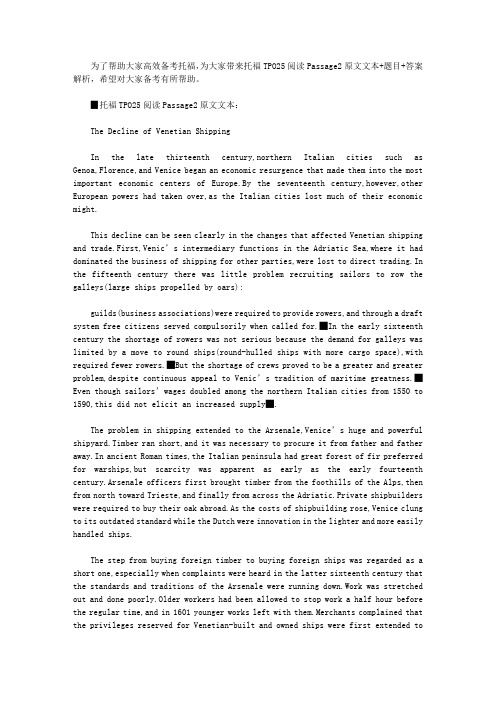
为了帮助大家高效备考托福,为大家带来托福TPO25阅读Passage2原文文本+题目+答案解析,希望对大家备考有所帮助。
▉托福TPO25阅读Passage2原文文本: The Decline of Venetian Shipping In the late thirteenth century,northern Italian cities such as Genoa,Florence,and Venice began an economic resurgence that made them into the most important economic centers of Europe.By the seventeenth century,however,other European powers had taken over,as the Italian cities lost much of their economic might. This decline can be seen clearly in the changes that affected Venetian shipping and trade.First,Venic’s intermediary functions in the Adriatic Sea,where it had dominated the business of shipping for other parties,were lost to direct trading.In the fifteenth century there was little problem recruiting sailors to row the galleys(large ships propelled by oars): guilds(business associations)were required to provide rowers,and through a draft system free citizens served compulsorily when called for.█In the early sixteenth century the shortage of rowers was not serious because the demand for galleys was limited by a move to round ships(round-hulled ships with more cargo space),with required fewer rowers.█But the shortage of crews proved to be a greater and greater problem,despite continuous appeal to Venic’s tradition of maritime greatness.█Even though sailors’wages doubled among the northern Italian cities from 1550 to 1590,this did not elicit an increased supply█. The problem in shipping extended to the Arsenale,Venice’s huge and powerful shipyard.Timber ran short,and it was necessary to procure it from father and father away.In ancient Roman times,the Italian peninsula had great forest of fir preferred for warships,but scarcity was apparent as early as the early fourteenth century.Arsenale officers first brought timber from the foothills of the Alps,then from north toward Trieste,and finally from across the Adriatic.Private shipbuilders were required to buy their oak abroad.As the costs of shipbuilding rose,Venice clung to its outdated standard while the Dutch were innovation in the lighter and more easily handled ships. The step from buying foreign timber to buying foreign ships was regarded as a short one,especially when complaints were heard in the latter sixteenth century that the standards and traditions of the Arsenale were running down.Work was stretched out and done poorly.Older workers had been allowed to stop work a half hour before the regular time,and in 1601 younger works left with them.Merchants complained that the privileges reserved for Venetian-built and owned ships were first extended tothose Venetians who bought ships from abroad and then to foreign-built and owned vessels.Historian Frederic Lane observes that after the loss of ships in battle in the late sixteenth century,the shipbuilding industry no long had the capacity to recover that it had displayed at the start of the century. The conventional explanation for the loss of Venetian dominance in trade is establishment of the Portuguese direct sea route to the East,replacing the overland Silk Road from the Black sea and the highly profitable Indian Ocean-caravan-eastern Mediterranean route to Venice.The Portuguese Vasco da Gama’s Voyaga around southern Africa to India took place at the end of the fifteenth century,and by 1502 the trans-Abrabian caravan route had been cut off by political unrest. The Venetian Council finally allowed round ships to enter the trade that was previously reserved for merchant galleys,thus reducing transport cost by one third.Prices of spices delivered by ship from the eastern Mediterranean came to equal those of spices transported by Paortuguese vessels,but the increase in quantity with both routes in operation drove the price far down.Gradually,Venice’s role as a storage and distribution center for spices and silk,dyes cotton,and gold decayed,and by the early seventeenth century Venice had lost its monopoly in markets such as France and southern Germany. Venetian shipping had started to decline from about 1530-before the entry into the Mediterranean of large volumes of Dutch and Britishshipping-and was clearly outclassed by the end of the century.A contemporary of Shakespeare(1564-1616)observed that the productivity of Italian shipping had declined,compared with that of the British,because of conservatism and loss of expertise.Moreover,Italian sailors were deserting and emigrating,and captains,no longer recruited from the ranks of nobles,were weak on navigations. This decline can be seen clearly in the changes that affected Venetian shipping and trade.First,Venic’s intermediary functions in the Adriatic Sea,where it had dominated the business of shipping for other parties,were lost to direct trading.century there was little In the fifteenth problem recruiting sailors to row the galleys(large ships propelled by oars):guilds(business associations)were required to provide rowers,and through a draft system free citizens served compulsorily when called for.█In the early sixteenth century the shortage of rowers was not serious because the demand for galleys was limited by a move to round ships(round-hulled ships with more cargo space),with required fewer rowers.█But the shortage of crews proved to be a greater and greater problem,despite continuous appeal to Venic’s tradition of maritime greatness.█Even though sailors’wages doubled among the northern Italian cities from 1550 to 1590,this did not elicit an increased supply█. ▉托福TPO25阅读Passage2题目:。
托福TPO29阅读Passage2原文文本+题目+答案解析
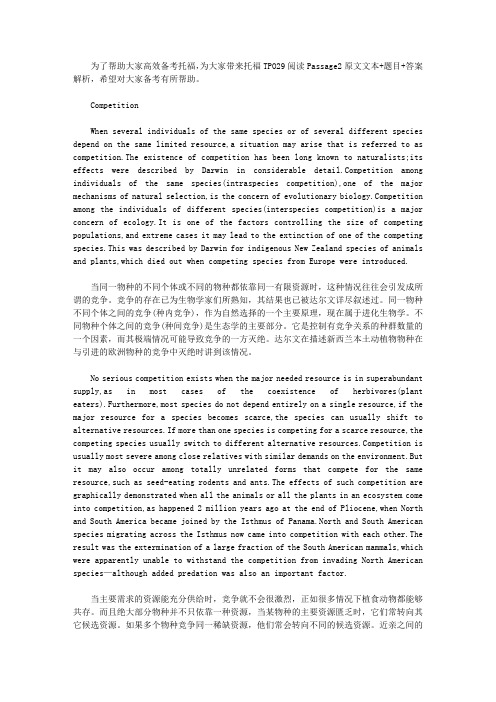
为了帮助大家高效备考托福,为大家带来托福TPO29阅读Passage2原文文本+题目+答案解析,希望对大家备考有所帮助。
Competition When several individuals of the same species or of several different species depend on the same limited resource,a situation may arise that is referred to as competition.The existence of competition has been long known to naturalists;its effects were described by Darwin in considerable petition among individuals of the same species(intraspecies competition),one of the major mechanisms of natural selection,is the concern of evolutionary petition among the individuals of different species(interspecies competition)is a major concern of ecology.It is one of the factors controlling the size of competing populations,and extreme cases it may lead to the extinction of one of the competing species.This was described by Darwin for indigenous New Zealand species of animals and plants,which died out when competing species from Europe were introduced. 当同一物种的不同个体或不同的物种都依靠同一有限资源时,这种情况往往会引发成所谓的竞争。
说明文2阅读答案
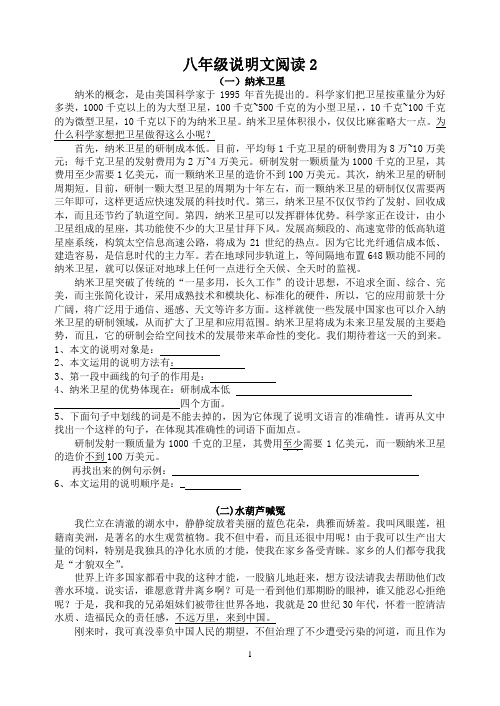
八年级说明文阅读2(一)纳米卫星纳米的概念,是由美国科学家于1995年首先提出的。
科学家们把卫星按重量分为好多类,1000千克以上的为大型卫星,100千克~500千克的为小型卫星,,10千克~100千克的为微型卫星,10千克以下的为纳米卫星。
纳米卫星体积很小,仅仅比麻雀略大一点。
为什么科学家想把卫星做得这么小呢?首先,纳米卫星的研制成本低。
目前,平均每1千克卫星的研制费用为8万~10万美元;每千克卫星的发射费用为2万~4万美元。
研制发射一颗质量为1000千克的卫星,其费用至少需要1亿美元,而一颗纳米卫星的造价不到100万美元。
其次,纳米卫星的研制周期短。
目前,研制一颗大型卫星的周期为十年左右,而一颗纳米卫星的研制仅仅需要两三年即可,这样更适应快速发展的科技时代。
第三,纳米卫星不仅仅节约了发射、回收成本,而且还节约了轨道空间。
第四,纳米卫星可以发挥群体优势。
科学家正在设计,由小卫星组成的星座,其功能使不少的大卫星甘拜下风。
发展高频段的、高速宽带的低高轨道星座系统,构筑太空信息高速公路,将成为21世纪的热点。
因为它比光纤通信成本低、建造容易,是信息时代的主力军。
若在地球同步轨道上,等间隔地布置648颗功能不同的纳米卫星,就可以保证对地球上任何一点进行全天候、全天时的监视。
纳米卫星突破了传统的“一星多用,长久工作”的设计思想,不追求全面、综合、完美,而主张简化设计,采用成熟技术和模块化、标准化的硬件,所以,它的应用前景十分广阔,将广泛用于通信、遥感、天文等许多方面。
这样就使一些发展中国家也可以介入纳米卫星的研制领域,从而扩大了卫星和应用范围。
纳米卫星将成为未来卫星发展的主要趋势,而且,它的研制会给空间技术的发展带来革命性的变化。
我们期待着这一天的到来。
1、本文的说明对象是:2、本文运用的说明方法有:3、第一段中画线的句子的作用是:4、纳米卫星的优势体现在:研制成本低四个方面。
5、下面句子中划线的词是不能去掉的,因为它体现了说明文语言的准确性。
新标准大学英语长篇阅读2

新标准大学英语长篇阅读2
新标准大学英语长篇阅读2是一本为大学生编写的英语教材,旨在帮助学生提高阅读能力,拓展词汇量,增强语言表达能力。
本书共分为六个单元,每个单元涵盖了不同主题的文章,内容涉及社会、文化、科技等多个领域,既能帮助学生了解世界各地的文化和风土人情,又能拓展学生的知识面,提高他们的综合素质。
在学习本书的过程中,学生不仅能够提高阅读速度和理解能力,还能通过阅读不同主题的文章,培养自己的思维能力和分析能力。
同时,本书还提供了丰富的词汇和语法练习,帮助学生巩固所学知识,提高语言表达能力。
每篇文章都精心选取,内容丰富多彩,语言生动优美。
通过阅读这些文章,学生能够了解不同国家的文化传统、风土人情,增长见识,开阔视野。
同时,这些文章还能引发学生对于社会、科技等方面的思考,激发学生的学习兴趣,激励他们积极思考,勇于探索未知领域。
本书的编写注重了语言的生动性和实用性,文章内容贴近生活,贴近学生的学习和生活实际,让学生在阅读的过程中能够感受到语言的魅力,增强学习的乐趣。
同时,本书还提供了丰富的课后练习和参考答案,方便学生巩固所学知识,检验学习效果。
总之,新标准大学英语长篇阅读2是一本内容丰富、贴近生活、注重实用性的英语教材,适合大学生使用。
通过学习本书,学生不仅能够提高英语阅读能力,还能够拓展知识面,增强综合素质,是一本理想的英语教材。
考研真题历年英语二阅读
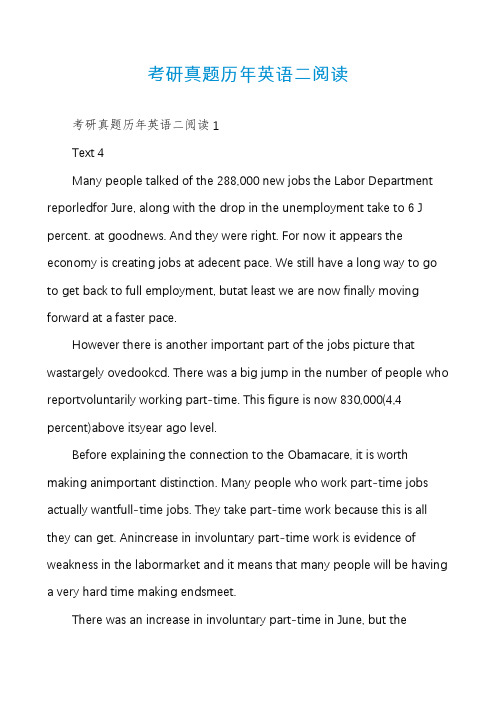
考研真题历年英语二阅读考研真题历年英语二阅读1Text 4Many people talked of the 288,000 new jobs the Labor Department reporledfor Jure, along with the drop in the unemployment take to 6 J percent. at goodnews. And they were right. For now it appears the economy is creating jobs at adecent pace. We still have a long way to go to get back to full employment, butat least we are now finally moving forward at a faster pace.However there is another important part of the jobs picture that wastargely ovedookcd. There was a big jump in the number of people who reportvoluntarily working part-time. This figure is now 830,000(4,4 percent)above itsyear ago level.Before explaining the connection to the Obamacare, it is worth making animportant distinction. Many people who work part-time jobs actually wantfull-time jobs. They take part-time work because this is all they can get. Anincrease in involuntary part-time work is evidence of weakness in the labormarket and it means that many people will be having a very hard time making endsmeet.There was an increase in involuntary part-time in June, but thegeneraldirection has been down. Involuntary part-time employment is still far higherthan before the recession, but it is down by 640,000(7.9 percent)from its yearago level.We know the difference between voluntary and involuntary part-timeemployment because people tell us. The survey used by the Labor Department askspeople if they worked less than 35 hours in the reference week. If the answer is“yes."they are classified as working part-time. The survey then asks whetherthey worked less than 35 hours in that week because they wanted to work lessthan full time or because they had no choice. They are only elassified asvoluntary part-time workers if they tell the survey taker they chose to workless than 35 hours a week.The issue of voluntary part-time relates to Obamacare becanse one of themain purposes was to allow people to get insurance outside of employment. Formany people, especially those with serious health conditions or family memberswith serious health conditions, before Obamacare the only way to get insurancewas through a job that provided health insurance.However, Obamacare has allowed more than 12 million people to either getinsurance through Medicaid or the exchanges. These are people who may previouslyhave felt the need to get a full-time job that provided insurance in order tocover themselves and their families. With Obamacare there is no longer a linkbetween employment and insurance.36. Which part of the jobs picture was neglected?A. The prospect of a thriving job market.B. The increase of voluntary part-time jobs.C. The possibility of full employment.D. The acceleration of job creation.37. Many people work part-time because theyA. prefer part-time jobs to full-time jobsB. feel that is enough to make ends meetC. cannot get their hands on full-time jobsD. haven' t seen the weakness of the market38. Involuntary part-time employment in the USA. is harder to acquire than one year agoB. shows a general tendency of declineC. satisfies the real need of the joblessD. is lower than before the recession39. It can be learned that with Obamacare, .A. it is no longer easy for part-timers to get insuranceB. employment is no longer a precondition to get insuranceC. it is still challenging to get insurance for family membersD. full-time employment is still essential for insurance40. The text mainly discusses.A. employment in the USB. part-timer classificationC. insurance through MedicaidD. Obamacare's trouble考研真题历年英语二阅读2Text 4When the government talks about infrastructure contributing to the economythe focus is usually on roads, railways, broadband and energy. Housing is seldommentioned.Why is that? To some extent the housing sector must shoulder the blame. Wehave not been good at communicating the real value that housing can contributeto economic growth. Then there is the scale of the typical housing project. Itis hard to shove for attention among multibillion-pound infrastructure project,so it is inevitable that the attention is focused elsewhere. But perhaps themost significant reason is that the issue has always been so politicallycharged.Nevertheless, the affordable housing situation is desperate. Waiting listsincrease all the time and we are simply not building enough new homes.The comprehensive spending review offers an opportunity for the governmentto help rectify this. It needs to put historical prejudices to one side and takesome steps to address our urgent housing need.There are some indications that it is preparing to do just that.Thecommunities minister, Don Foster, has hinted that George Osborne, Chancellor ofthe Exchequer, may introduce more flexibility to the current cap on the amountthat local authorities can borrow against their housing stock debt. Evidenceshows that 60,000 extra new homes could be built over the next five years if thecap were lifted, increasing GDP by 0.6%.Ministers should also look at creating greater certainty in the rentalenvironment, which would have a significant impact on the ability of registeredproviders to fund new developments from revenues.But it is not just down to the government. While these measures would bewelcome in the short term, we must face up to the fact that the existing ?4.5bnprogramme of grants to fund new affordable housing, set to expire in 2022年,isunlikely to be extended beyond then. The Labour party has recently announcedthat it will retai n a large part of the coalition’s spending plans if returns topower. The housing sector needs to accept that we are very unlikely to everreturn to era of large-scale public grants. We need to adjust to this changingclimate.36. The author believes that the housing sector__[A] has attracted much attention[B] involves certain political factors[C] shoulders too much responsibility[D] has lost its real value in economy37. It can be learned that affordable housing has__[A] increased its home supply[B] offered spending opportunities[C] suffered government biases[D] disappointed the government38. According to Paragraph 5,George Osborne may_______.[A] allow greater government debt for housing[B] stop local authorities from building homes[C] prepare to reduce housing stock debt[D] release a lifted GDP growth forecast39.It can be inferred that a stable rental environment would_______.[A]lower the costs of registered providers[B]lessen the impact of government interference[C]contribute to funding new developments[D]relieve the ministers of responsibilities40.The author believes that after 2022年,the government may______.[A]implement more policies to support housing[B]review the need for large-scale public grants[C]renew the affordable housing grants programme[D]stop generous funding to the housing sector考研真题历年英语二阅读3Text 4Europe is not a gender-equality heaven.In particular, thecorporateworkplace will never be completely family—friendly until women are part ofsenior management decisions,and Europe,s top corporate-governance positionsremain overwhelmingly male .indeed,women hold only 14 percent of positions onEurope corporate boards.The Europe Union is now considering legislation to compel corporate boardsto maintain a certain proportion of women-up to 60 percent.This proposed mandatewas born of frustration. Last year, Europe Commission Vice President VivianeReding issued a call to voluntary action. Reding invited corporations to sign upfor gender balance goal of 40 percent female board membership. But her appealwas considered a failure: only 24 companies took it up.Do we need quotas to ensure that women can continue to climb the corporateLadder fairy as they balance work and family?“Personally, I don’t like quotas,” Reding said recently. “But i like whatthe quotas do.” Quotas get action: they “open the way to equality and they breakthrough the glass ceiling,” according to R eding, a result seen in France andother countries with legally binding provisions on placing women in top businesspositions.I understand Reding’s reluctance-and her frustration. I don’t like quotaseither; they run counter to my belief in meritocracy, government by the capable.Bur, when one considers the obstacles to achieving the meritocratic ideal, itdoes look as if a fairer world must be temporarilyordered.After all, four decades of evidence has now shown that corporations inEurope as the US are evading the meritocratic hiring and promotion of women totop position—no matter how much “soft pressure ” is put upon them. When womendo break through to the summit of corporate power--as, for example, SherylSandberg recently did at Facebook—they attract massive attention preciselybecause they remain the exception to the rule.If appropriate pubic policies were in place to help all women---whetherCEOs or their children’s caregivers--and all families, Sandberg would be no morenewsworthy than any other highly capable person living in a more justsociety.36. In the European corporate workplace, generally_____.[A] women take the lead[B] men have the final say[C] corporate governance is overwhelmed[D] senior management is family-friendly37. The European Union’s intended legislation is ________.[A] a reflection of gender balance[B] a reluctant choice[C] a response to Reding’s call[D] a voluntary action38. According ti Reding, quotas may help women ______.[A] get top business positions[B] see through the glass ceiling[C] balance work and family[D] anticipate legal results39. The author’s attitude toward Reding’s appeal is one of _________.[A] skepticism[B] objectiveness[C] indifference[D] approval40. Women entering top management become headlines due to the lack of______.[A] more social justice[B] massive media attention[C] suitable public policies[D] greater “soft pressure”考研真题历年英语二阅读4Text 4It‘s no surprise that Jennifer Senior’s insightful,provocative magazinecover story,“I love My Children,I Hate My Life,” is arousing much chatter –nothing gets people talking like the suggestion that child rearing is anythingless than a completely fulfilling,life-enriching experience. Rather thanconcluding that children make parentseither happy or miserable,Senior suggestswe need to redefine happiness:instead of thinking of it as something that canbe measured by moment-to-moment joy,we should consider being happy as apast-tense condition. Even though the day-to-day experience of raising kids canbe soul-crushingly hard,Senior writes that “the very things that in the momentdampen our moods can later be sources of intensegratifica tion and delight.”The magazine cover showing an attractive mother holding a cute baby ishardly the only Madonna-and-child image on newsstands this week. There are alsostories about newly adoptive – and newly single –mom Sandra Bullock,as well asthe usual “Jennifer Aniston is pregnant” news. Practically every week featuresat least one celebrity mom,or mom-to-be,smiling on the newsstands.In a society that so persistently celebrates procreation,is it any wonderthat admitting you regret having children is equivalent to admitting you supportkitten-killing ? It doesn‘t seem quite fair,then,to compare the regrets ofparents to the regrets of the children. Unhappy parents rarely are provoked towonder if they shouldn’t have had kids,but unhappy childless folks are botheredwith the message that children are the single most important thing in the world:obviously their misery must be a direct result of the gaping baby-size holes intheir lives.Of course,the image of parenthood that celebrity magazines like Us Weeklyand People present is hugely unrealistic,especially when the parents are singlemothers like Bullock. According to several studies concluding that parents areless happy than childless couples,single parents are the least happy of all. Noshock there,considering how much work it is to raise a kid without a partner tolean on; yet to hear Sandra and Britney tell it,raising a kid on their “own”(read:with round-the-clock help) is a piece of cake.It‘s hard to imagine that many people are dumb enough to want children justbecause Reese and Angelina make it look so glamorous:most adults understandthat a baby is not a haircut. But it’s interesting to wonder if the images wesee every week of stress-free,happiness-enhancing parenthood aren‘t in somesmall,subconscious way contributing to our own dissatisfactions with the actualexperience,in the same way that a small part of us hoped getting “ the Rachel”might make us look just a little bit like Jennifer Aniston.36.Jennifer Senior suggests in her article that raising a child canbring[A]temporary delight[B]enjoyment in progress[C]happiness in retrospect[D]lasting reward37.We learn from Paragraph 2 that[A]celebrity moms are a permanent source for gossip.[B]single mothers with babies deserve greater attention.[C]news about pregnant celebrities is entertaining.[D]having children is highly valued by the public.38.It is suggested in Paragraph 3 that childless folks[A]are constantly exposed to criticism.[B]are largely ignored by the media.[C]fail to fulfill their social responsibilities.[D]are less likely to be satisfied with their life.39.According to Paragraph 4,the message conveyed by celebrity magazinesis[A]soothing.[B]ambiguous.[C]compensatory.[D]misleading.40.Which of the following can be inferred from the last paragraph?[A]Having children contributes little to the glamour of celebrity moms.[B]Celebrity moms have influenced our attitude towards child rearing.[C]Having children intensifies our dissatisfaction with life.[D]We sometimes neglect the happiness from child rearing.。
- 1、下载文档前请自行甄别文档内容的完整性,平台不提供额外的编辑、内容补充、找答案等附加服务。
- 2、"仅部分预览"的文档,不可在线预览部分如存在完整性等问题,可反馈申请退款(可完整预览的文档不适用该条件!)。
- 3、如文档侵犯您的权益,请联系客服反馈,我们会尽快为您处理(人工客服工作时间:9:00-18:30)。
Read the information ,then answer the questions. Give the answers.
The Cat Family
The Siberian tiger is the largest and strongest member of the cat
family. It weighs up to 300kg and is 4.5m long.
The cheetah is the fastest land animal. It can run at 114km per hour.
The Dog family
The wolf is the largest member of the dog family. It weighs about 45kg
and is about 2.5m long.
The coyote is the best runner and jumper in the dog family. It can run
at 40to 50km per hour. It can jump about 7m high.
Whales and Dolphins
Whales and dolphins are not fish. One kind of whale is the blue whale.
It is the loudest animal on Earth. Its song can travel for many kilometers
in the ocean. It is also the fastest sea animal. It can swim at about 49km
per hour.
Dolphins are smaller than whales. One kind of dolphin is the killer
whale. The name ‘killer whale’may make people think it is a whale. But
it actually belongs to the dolphin family. It is the largest of all
dolphins and the fiercest and most powerful member of the family.
Answer the questions. Give short answers.
1.Find a word that means ‘sea’.
2.Find a phrase that means ‘an animal or person that runs faster than
any other animal or person’.
two members of the cat family talked about on the website.
The and the .
4.Which can run faster, the cheetah or the coyote?
5. Which animal is the strongest fighter in the dolphin family?
Find words to finish the sentences.
1.The killer whale is a of the dolphin family.
2.The elephant is the heaviest land animal. It can weigh up to
9000 .
3.The longest snake in the world is the python.It can be up to 15 long.。
